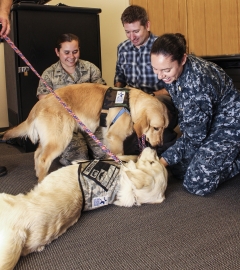Posted June 26, 2015
Patricia A. Deuster, Ph.D., MPH; Uniformed Services University of Health Sciences
 Approximately 7-8% of Americans are affected by post-traumatic stress disorder (PTSD) at some point in their lifetimes. Military personnel exposed to trauma are at a particularly high risk for developing PTSD; out of Afghanistan/Iraq Veterans alone, about 11-20% of these Veterans have PTSD in any given year*. In addition to debilitating symptoms such as recurrent distressing memories, increased emotional arousal (and/or numbing), and impaired social interactions, PTSD affects the body's primary stress response systems - the autonomic nervous system and the hypothalamic-pituitary-adrenal (HPA) axis. Although medications are commonly prescribed to provide balance to these systems and alleviate symptoms, these medications are often associated with harsh side effects. Consequently, many patients elect not to take them. Moreover, not all patients respond to psychotherapies or are willing to accept them.
Approximately 7-8% of Americans are affected by post-traumatic stress disorder (PTSD) at some point in their lifetimes. Military personnel exposed to trauma are at a particularly high risk for developing PTSD; out of Afghanistan/Iraq Veterans alone, about 11-20% of these Veterans have PTSD in any given year*. In addition to debilitating symptoms such as recurrent distressing memories, increased emotional arousal (and/or numbing), and impaired social interactions, PTSD affects the body's primary stress response systems - the autonomic nervous system and the hypothalamic-pituitary-adrenal (HPA) axis. Although medications are commonly prescribed to provide balance to these systems and alleviate symptoms, these medications are often associated with harsh side effects. Consequently, many patients elect not to take them. Moreover, not all patients respond to psychotherapies or are willing to accept them.
Dr. Patricia Deuster, Professor at the Uniformed Services University of the Health Sciences (USUHS) and Director for the Consortium for Health and Military Performance (CHAMP), is currently researching an alternative to traditional drug and/or psychotherapy. This alternative involves having Service Members suffering from PTSD train service dogs to provide mobility assistance and social support to fellow physically-disabled Veterans. "Many people have a sense that having a Service Member participate in the training of service dogs would be an amazing therapy," says Dr. Deuster, "but we cannot bring it into mainstream practice until we have a scientific base." Dr. Deuster strives to provide this scientific base by studying the effects of human-animal interactions (HAI) on Service Members with PTSD through her research funded by a CDMRP Clinical Research Intramural Initiative award. For this effort, her team at USUHS has partnered with the nonprofit organization Warrior Canine Connection (WCC) to evaluate the effectiveness of their service dog training program (SDTP) - or "canine connection therapy" - in improving emotional regulation in Service Members with PTSD.
With over 30 years of research experience, Dr. Deuster has led several efforts on integrative health and neuroendocrine responses to stress. This study hypothesizes that HAI will decrease symptoms of PTSD and improve physiological and neurobiological responses in subjects at rest and in response to stress. PTSD patients are referred to the study from the Walter Reed National Military Medical Center Adult Outpatient Behavioral Health Clinic. Patients are then randomly assigned to a two-week SDTP or a waitlist control group. Psychological, physiological and neuroendocrine measures are taken before and after the two-week period, both at rest and in response to an exercise challenge. To scientifically support the claim that the SDTP can be an effective, non-pharmacological intervention program for Service Members with PTSD, Dr. Deuster and her group are looking for signs such as improved symptoms of PTSD and measures of mood, sleep, and psychosocial status. Other measures include improved HPA axis and autonomic nervous system function, up-regulation of oxytocin (a neurobiological promotor of social behavior and stress reduction), and down-regulation of arginine vasopressin (a factor linked to increased stress reactivity and anxiety).
Recruitment and data collection are currently ongoing, and Dr. Deuster believes that establishing the SDTP as a valid intervention for improving psychosocial function can eventually lead to increased development of long-term behavioral programs, rather than prescription drugs, to treat PTSD. Positive findings from this study could also provide the basis for testing the efficacy of the SDTP as a treatment for other psychological issues, such as panic attacks or depression.
Looking beyond the science, the heart of the SDTP lies in its ability to engage Service Members, some of whom are resistant to any type of treatment. "Having a wounded, injured, or ill Service Member learn to train a service dog gives them a purpose in life because they know the dog they are training will go to help a buddy," explains Dr. Deuster. "The unconditional love they get from the dog makes them feel valued." As the research on SDTPs and HAIs continues, Dr. Deuster is hopeful that the treatment for these invisible wounds will continue to improve in both military and civilian care.
*PTSD: National Center for PTSD. "How Common is PTSD?" U.S. Department of Veterans Affairs, 10 Nov. 2014 Web. 11 June 2015 (http://www.ptsd.va.gov/PTSD/public/PTSD-overview/basics/how-common-is-ptsd.asp)

Therapy dogs from the Warrior Canine Connection are employed in the SDTP in an effort to ease PTSD symptoms in Service Members and help improve positive social behavior.
The photo credit: MC3 Laura Bailey, Uniformed Services University














